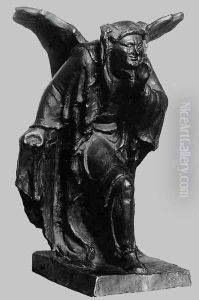Hermann Ernst Freund Paintings
Hermann Ernst Freund was a notable Danish sculptor of German origin, born on October 15, 1786, in Uthlede, a small town in the Duchy of Bremen, which was then a part of the Holy Roman Empire. His early life in Germany laid the foundation for his artistic journey, but it was in Denmark where his career truly flourished and where he eventually became a central figure in the Danish Golden Age of art, a period marked by an extraordinary flourishing of the visual arts, literature, and science.
Freund's initial foray into the world of art began with an apprenticeship under a house painter, but his talent and interest in sculpture soon led him to pursue formal education. In 1805, he moved to Copenhagen to study at the Royal Danish Academy of Fine Arts, where he honed his skills and absorbed the neoclassical influences that were predominant at the time. His studies were complemented by travels to Rome in 1810, a trip that was instrumental in his development as an artist. In Rome, Freund was deeply influenced by classical and Renaissance art, as well as by the contemporary works of Bertel Thorvaldsen, a fellow Dane who had established himself as one of the era’s leading sculptors. This experience enriched Freund's artistic vocabulary, blending classical ideals with a burgeoning romantic sensibility.
Throughout the 1820s and 1830s, Freund emerged as a key figure in Danish sculpture, pioneering the use of Nordic mythology and history as central themes in his works. This was a departure from the classical subjects that had dominated European sculpture, reflecting a broader romantic interest in national identity and the cultural heritage of one's own country. One of his most famous works, 'The Ragnarok Frieze,' depicted scenes from Norse mythology, showcasing his skill in narrative composition and his ability to imbue his sculptures with a sense of drama and emotion.
Freund's contributions to Danish art were not limited to his own creations. He was also a respected educator, teaching at the Royal Danish Academy of Fine Arts, where he influenced a new generation of artists. His commitment to the academy and his students helped to sustain the vibrant artistic community in Denmark during the first half of the 19th century.
Hermann Ernst Freund's legacy is marked by his pioneering role in incorporating Nordic themes into sculpture, his mastery of form and expression, and his influence as a teacher. Though he passed away on June 30, 1840, in Copenhagen, his works continue to be celebrated for their innovative approach and contribution to the Danish Golden Age. Freund's sculptures can be found in museums and collections in Denmark and abroad, serving as enduring testaments to his artistic vision and the rich cultural period in which he worked.

